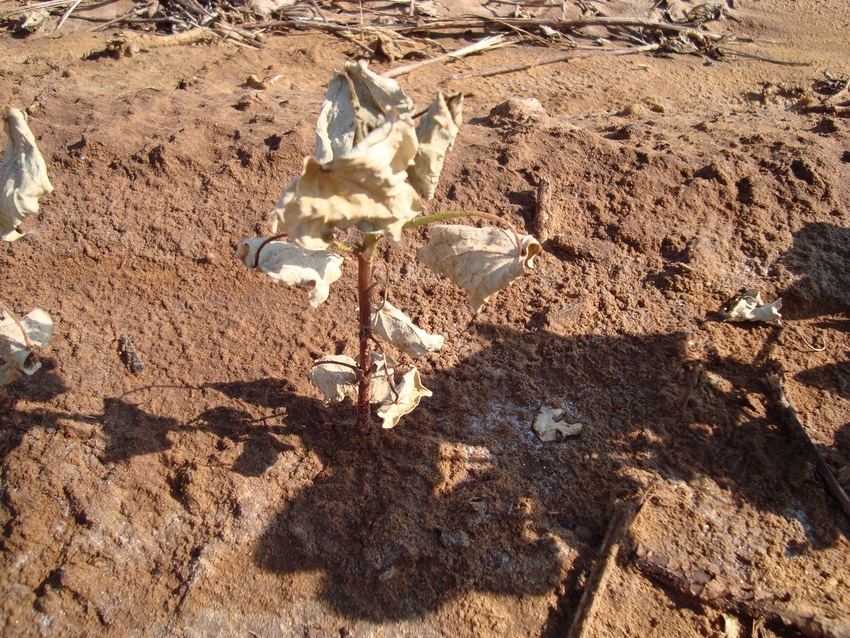
Hold the salt, please. That’s easy enough to do with a plate of blackeyed peas or a packet of fried potatoes, but not so much on cropland that’s irrigated with high salinity water or during hot, droughty periods with high evapotranspiration rates.
Too much salt isn’t good for plant health. Soils with high salinity levels compete with plants for water and plants may be stressed, even when the soil is moist, says Texas A&M AgriLife Extension Agricultural Engineer Dana Porter.
“Soil aggregates disperse, leading to surface sealing,” she said at the recent Oklahoma Irrigation Conference in Fort Cobb, explaining that sodicity (excessive sodium in soils) may affect soil structure.
For the latest on southwest agriculture, please check out Southwest Farm Press Daily and receive the latest news right to your inbox.
Salinity has been common throughout much of the Southwest over the course of the four-year drought cycle (more or less, depending on location). “We’ve been through the wringer with salinity issues in the southwest part of Oklahoma,” says Randy Boman, Oklahoma State University Extension State Cotton Leader and Director of the Southwest Research and Extension Center in Altus.
“Salinity can cause late season defoliation in cotton.” Boman said in discussing cotton irrigation management.
Can be toxic
Salts are naturally-occuring in the soil, Porter says, but they also accumulate from irrigation water, fertilizers, and soil amendments. Salts may concentrate in the soil, at the wetting front, near or at the soil surface. Some are taken up by plants, but that depends on the plant species and the type of salt. Leaching can carry salts below the root zone, and dilution can help keep salts at safe concentrations.
Salts can also be toxic to plants, she says. “Some elements, including micronutrients, can be toxic at excessive levels. Some plants are particularly susceptible to foliar injury from sodium and chloride, for instance. The irrigation method may also influence risk of foliar salt injury .”
A “fine line” exists between boron deficiency and toxicity, Porter says, with different crops varying in sensitivity. Availability of iron and other elements depends on pH and other factors, which can make a difference between potential toxicity and deficiency.
Options for producers
Managing soil salinity may pose challenges to producers, but they do have options, Porter says. She recommends:
Minimize applications of salts (from irrigation water and soil amendments).
Be mindful of crop selection; some crops and varieties are more sensitive to salts than others.
Consider irrigation leaching, as needed, to move salts below the root zone.
Method of irrigation can make a difference.
Seedbed and field management strategies are important considerations.
Schedule irrigation to manage (or minimize) salt accumulation.
Subsurface drip Irrigation management should include additional water quality considerations to prevent emitter plugging.
Crops have different tolerances to irrigation water and soil salinity, Porter says. Corn and alfalfa have low tolerance, while cotton and barley have higher salt tolerance. At threshold salt concentration levels, yield loss for crops susceptible to both water and soil salinity may be significant.
Leaching salts from near the soil surface to below the root zone minimizes plant damage, she says. “Frequent irrigation keeps salts in solution for easier leaching. Leaching also may move salts and other constituents to shallow groundwater springs and seeps that can affect water quality.”
Irrigation method also plays a role. “More efficient irrigation methods allow for greater leaching with the same quantity of water. LEPA and drip systems minimize evaporation and prevent foliar injury from salt.”
Rainfall helps
Boman says one of the best things for leaching salt out of the root zone is rainfall. “With high saline soils, we just hope for rain. Rainfall this year helped a lot — we cleaned up salinity quite a bit, but it is still not as clean as we would like to see it.”
Residue management also helps mitigate salinity, Porter says. “Mulch will reduce evaporation and therefore reduce salt concentration and accumulation.” Soil amendments help, too. “Gypsum or other amendments displace sodium in sodic soils. Leaching is still required to move the sodium below the root zone.”
Leaching varies with the soil, Porter notes. Soil compaction restricts water movement. She says salts tend to accumulate on the outer edge of irrigated furrows, so “where producers place plants can make a difference in avoiding injury.”
Wastewater and other lower quality water sources have become more widely used for irrigation during the recent drought, which creates new challenges. Wastewater should be tested, she says, to determine water quality. “Monitor soil chemistry when irrigating with wastewater; also know how much will be available, and will the source be consistent?”
Equipment concerns
Wastewater also creates equipment concerns, Porter says. ”Will the water clog irrigation parts? Will it be corrosive to equipment?” For micro-irrigation water quality concerns, she recommends producers check a webpage for more information on microirrigtion maintenance: www.micromaintain.ucanr.edu
Salts may damage irrigation systems, and the potential for damage varies with the material. “Some pipe materials are better than others, but are also more expensive,” she says. “Stainless steel, for instance, is costly.” Major irrigation equipment manufacturers offer products and materials (stainless steel, epoxy liners, high density polyethylene lined pipe) resistant to corrosion.
Porter says farmers may hear about new products to manage salts, but cautions: “Miracle products? Be skeptical!”
About the Author(s)
You May Also Like






